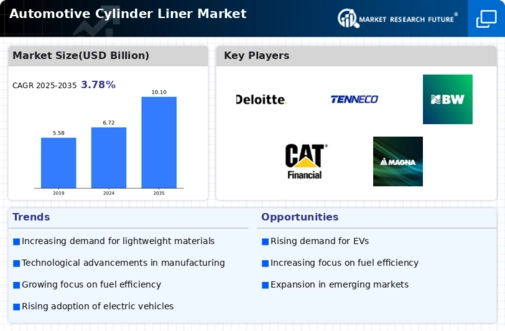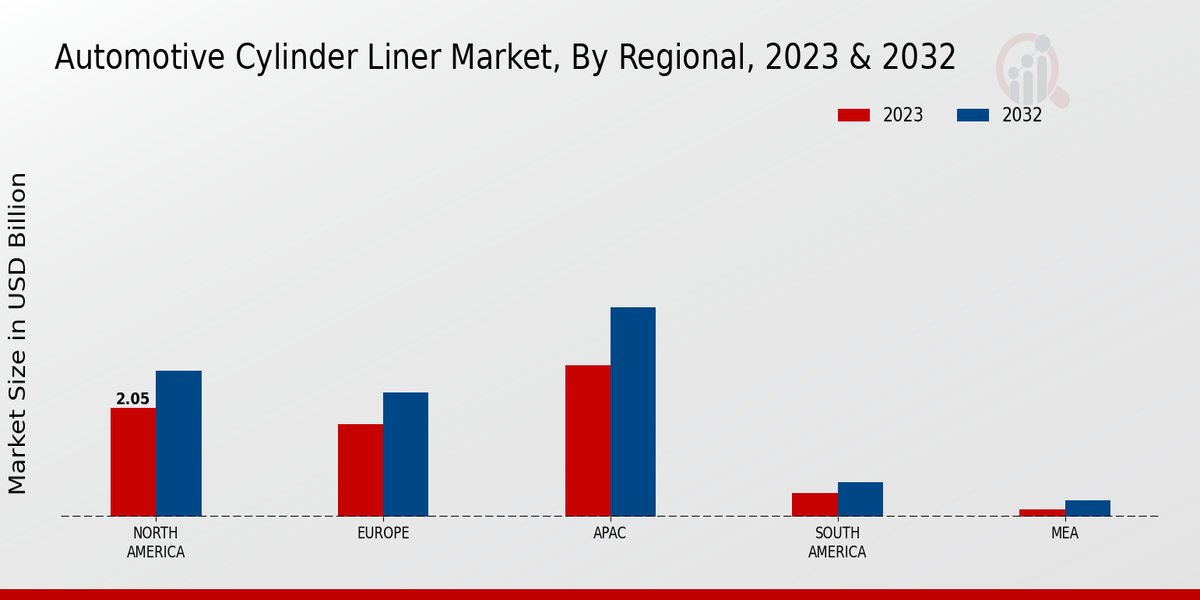Market Trends and Projections
The Global Automotive Cylinder Liner Market Industry is projected to experience steady growth, with key trends indicating a shift towards advanced materials and manufacturing processes. The market is expected to reach 6.72 USD Billion in 2024, with a forecasted growth to 10.1 USD Billion by 2035. The compound annual growth rate from 2025 to 2035 is estimated at 3.78%. This growth trajectory suggests a robust demand for innovative cylinder liner solutions that enhance engine performance and efficiency. As the automotive landscape evolves, manufacturers must adapt to these trends to remain competitive in the global market.
Increasing Demand for Fuel Efficiency
The Global Automotive Cylinder Liner Market Industry experiences heightened demand for fuel-efficient vehicles, driven by rising fuel prices and environmental concerns. Manufacturers are increasingly focusing on optimizing engine performance, which directly influences the design and production of cylinder liners. Enhanced fuel efficiency not only reduces operational costs for consumers but also aligns with global sustainability goals. As a result, the market is projected to grow from 6.72 USD Billion in 2024 to an estimated 10.1 USD Billion by 2035, reflecting a compound annual growth rate of 3.78% from 2025 to 2035. This trend underscores the importance of innovative cylinder liner technologies in meeting consumer expectations and regulatory standards.
Growth of Electric and Hybrid Vehicles
The rise of electric and hybrid vehicles presents both challenges and opportunities for the Global Automotive Cylinder Liner Market Industry. While the shift towards electric powertrains may reduce the demand for traditional internal combustion engine components, hybrid vehicles still rely on efficient engine designs that require high-quality cylinder liners. As the automotive industry transitions towards electrification, manufacturers are likely to focus on developing lightweight and efficient cylinder liners that cater to hybrid applications. This evolving landscape suggests that the market may adapt to new technologies while maintaining relevance in a changing automotive environment.
Technological Advancements in Engine Design
Technological advancements in engine design significantly impact the Global Automotive Cylinder Liner Market Industry. Innovations such as lightweight materials and advanced manufacturing techniques enhance the durability and performance of cylinder liners. For instance, the adoption of composite materials can lead to reduced weight and improved thermal efficiency. These advancements not only contribute to better fuel economy but also extend the lifespan of engine components. As automotive manufacturers continue to invest in research and development, the market is likely to witness a surge in demand for high-performance cylinder liners that meet the evolving needs of modern engines.
Regulatory Compliance and Emission Standards
The Global Automotive Cylinder Liner Market Industry is influenced by stringent regulatory compliance and emission standards imposed by governments worldwide. As nations implement more rigorous environmental regulations, automotive manufacturers are compelled to adopt technologies that minimize emissions. Cylinder liners play a crucial role in achieving these standards, as they directly affect engine efficiency and emissions output. Consequently, the market is expected to expand as manufacturers seek to develop liners that not only comply with regulations but also enhance overall vehicle performance. This regulatory landscape creates opportunities for innovation and growth within the cylinder liner sector.
Expansion of Automotive Manufacturing in Emerging Markets
The Global Automotive Cylinder Liner Market Industry benefits from the expansion of automotive manufacturing in emerging markets. Countries such as India, Brazil, and China are witnessing significant growth in vehicle production, driven by rising disposable incomes and urbanization. This surge in automotive manufacturing creates a robust demand for cylinder liners, as manufacturers seek to equip vehicles with efficient and durable engine components. The increasing production capacity in these regions is likely to contribute to the overall growth of the cylinder liner market, as local manufacturers strive to meet both domestic and international standards.

















Leave a Comment